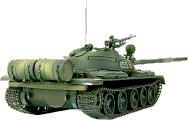Strategic Command - how to defeat the Royal Navy at Alexandria and win the War!
by Jim Biddle
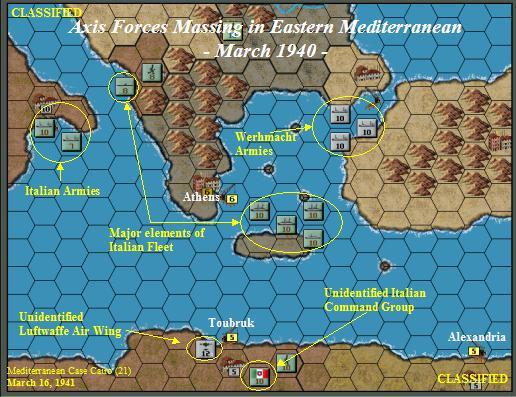
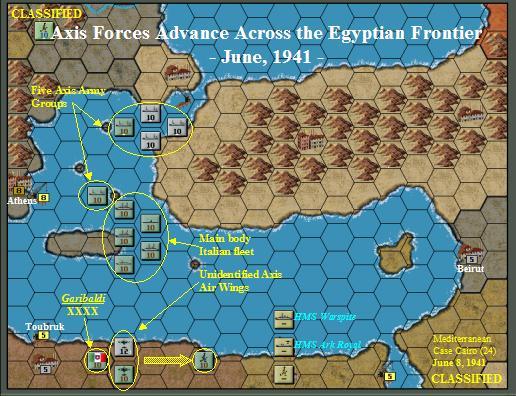
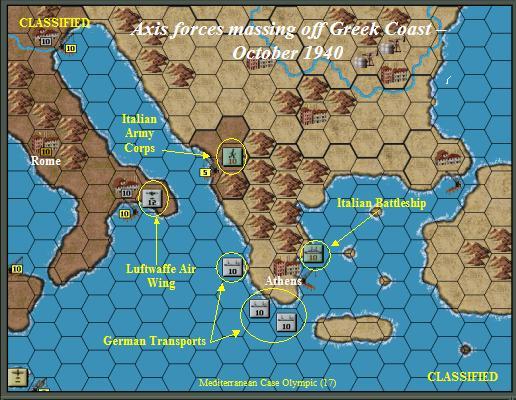
The following is rather protracted, but I believe that success in the Middle East for the Axis is part of a string of operations beginning immediately with the fall of Paris. I would also argue that Axis victory at Alexandria pretty much ensures ultimate Axis victory (including the taking of Washington DC) because capture of the Middle East oil fields along with Vichy France and Greece (assuming Yugoslavia Denmark and Norway and the Axis Minors) gives Germany greater raw economic potential than Russia very early in the Russian campaign which pretty much ensures complete victory east, which guarantees victory in the West. In addition, with the British threat in the Med largely destroyed, Italy can devote its entire resources to support operations in Russia or the Atlantic as well as be in position to block any Anglo-American attempts in France with out using German resources. The advantages of Mar Nostrum are incalculable.
I also suggest that the three German army groups and one air fleet required do not represent a significant drain from other fronts. The major expense comes to the Italians, but how where they going to contribute anyway? In addition, at the end of the Baghdad operation in late 1941 or early 1942, three veteran German armies, two veteran Italian armies, and tested Italian air forces with command and control become available for strategic surprise on another front.
The key to this strategy is concurrent preparation. Each operation draws on the previous and every thing done in a current operation is done with a future operation in mind. This is particularly relevant to the final positioning of assault troops, ships and air fleets at the end of a campaign; can they immediately go right into the next operation? In addition, conservation of resources is vital. Combat should not be sought that does not directly contribute to the next operation. In particular, the Italian Navy must avoid all non-mission critical fights with the Vichy fleet or RAF Malta. Money spent repairing Italian ships delays the construction of vital Italian air and HQ units and delays the operation to a point where the advantage over Russia is lost.
By using this strategy, and with simple luck on the dice, you should be able to be in full Axis control of Alexandria, and the Middle East Oilfields before the close of 1941 and zero losses to the Italians or Germans! However, a component of this strategy is to delay war with Russia for as long as possible. By careful distant deployment of troops on the Russian border and caution in each new declaration of war, I have been able to delay Russian entry often into early 1942, by which time, its too late for the commies, Germany has had too long to get ready for Barbarossa!
Jim Biddle, pvbt@yahoo.com
Extra - Paris Falls, Brits stand alone!
A triumphant German army marched into the French as an elated German Fuehrer danced a jig of elation and revenge! Versailles is dead. The world stands in wonder and apprehension at what the Nazis and their Italian lackeys will do next.
Case "Date Palm" - Objective Iraq
Phase I - Vichy France
Phase II - Greece (Optional but recommended)
Phase III - Alexandria and Suez
Phase IV - Baghdad
Phase V - The world!
Control of Middle East oil resources provides the critical economic wherewithal to ensure final victory on the Russian front and ultimate victory over the Anglo Americans. These objective can be achieved with minimal disruption to operations in France against Britain or the Eastern Front, however planning and execution must begin immediately upon the fall of Paris in order to achieve success in time to decisively influence events on the Russian front. Operations against Iraq should be successfully concluded not later than October 1941!
Operation Date Palm is actually a series of concurrent operations beginning immediately after completion of the French operation. Phase one involves the conquest of Vichy France (Fall 1940). Phase two is the defeat of Greece (Winter 1940). Phase three is the conquest of Egypt (Spring 1941). Phase four is the conquest of Iraq (summer 1941). Expect war with Russia in the spring or summer of 1941. Expect American entry into the war during the Egypt or Baghdad operations.
Phase I - Vichy France (August-September 1940)



Simultaneous attacks on Vichy European and African objectives by Anglo-German Forces immediately following the defeat of France. The conquest of Vichy France provides the following major strategic benefits:
1) Control of a North African port suitable for supporting future operations against Gibraltar.
2) Additional economic resources.
3) Control of French Palestine as a base of operations for a strike into Iraq.
Force allocation -
European operation:
1) An Italian Heavy Cruiser deployed to bombardment position off of Marseilles. As soon as Italy declares war, ships should being moving to position for operation Date Palm
2) One Italian Army and one Italian Army Corps deployed to the Vichy border in immediate striking range of Marseilles. These forces should already be in position as a result of the Attack on France.
3) Two German Armored groups deployed to positions along the Spanish border in immediate striking distance of Marseilles (Infantry may be used, however, armor can march east to Yugoslavia faster and at lower cost than infantry once the operation is complete). These forces should be drawn from those already in France as a result of the fall of Paris.
4) One German Army Group deployed on the Vichy border south east of Paris.
5) One German air fleet deployed south of Paris in striking range of Marseilles (seek to duel position the unit so that it can strike Marseilles while still supporting operations against England).
African operation:
1) One Italian submarine deployed to striking position of French naval units in North Africa.
2) Two Italian battleships deployed in bombardment positions around the North African capital. Naval deployment should being immediately upon Italian entry into the war.
3) Two Italian Army groups in landing positions, one each east and west of the city. These army groups can be drawn from those deployed in North Africa as Italy enters the war. Upon the Italian declaration of war, transport the Rome and Sicily Italian Army corps to Toubruk. As these corps disembark, transport the Toubruk army group to an area at sea near Corsica in position to move the landing points on the African coast. As the second Italian corps arrives at Toubruk, operationally move the first corps to Tunis and operationally move the Tunis army to Toubruk for embarkation to water off of Corsica for the Vichy operation. Both Tunis and Toubruk must be occupied in order to discourage UK action. The complicated operation ballad is necessary in order to prevent UK air out of Malta from destroying Tunis while it is unguarded.
4) One Italian or German air fleet temporarily deployed to Sicily in strike range of the North African target.
5) Avoid British air units at Malta if at all possible. The Eastern army group should not arrive in landing position until an Axis air unit is operational in Sicily in order to protect the army from strikes from Malta).
Greece operation (future):
1) Three German Army groups to sea embarkation points in Southern Italy drawn from the France force and operationally moved to Italy. Speed is critical.
2) One Italian Battleship to bombardment position off of Athens to depart immediately upon Italian declaration of war.
Execution phase I:
Once all forces are in final position and at full strength, typically one or two turns after the fall of Paris, begin the operation with a declaration of war against Vichy France. This will have only a modest impact American and Russian intervention factors. Remember that North African and European objective must be taken sim
ultaneously if the captured resources are to go the Germans. As such, this operation takes two full turns to complete.Europe turn 1 -
1) Bombard Marseilles with the Italian cruiser and then the German Air fleet.
2) Attack Marseilles directly with the Italian army group. Use the Italian corps to attack the French cruiser at Marseilles (damage will cause the cruiser to retreat rather than fight during the allied turn).
3) Attack Marseilles directly with the German armor until the defending French army is destroy. If the goal is to allocate the resources to Germany, do not seize the city at this point; leave it in allied hands for one turn until the Italians are able to take North Africa.
Africa turn I -
1) Bombard the city with the two Italian battleships and then the air fleet based in Sicily.
2) Strike the French battleship with the Italian submarine (this will cause the battleship to remain inactive or retreat during the allied turn). With the exception of the submarine attack, it is critical to avoid all naval battles with the Vichy fleet in order to conserve resources and time for operations against the British at Suez.
3) Land the Italian armies to the west and east of the city and attack directly until the defending army is destroying. With the French battleship in port, it is simply not cost effective to attempt to take the city in a single turn.
Europe turn 2 -
1) Take Marseilles with the German infantry army and begin moving German armor to the east for reassignment to either the future war in Yugoslavia or in Russia. The German air fleet can now be redeployed to support operations against British airpower.
2) The Italian army corps should move to sea embarkation position at Marseilles for deployment to occupation duty in North Africa. The Italian Army Group should march east to the Yugoslav border.
3) The Italian fleet should proceed immediately at best possible speed to the Aegean, avoiding any combat during the journey.
Africa turn 2 -
1) Take the objective city with one Italian army group. Position both army groups for immediate sea transport on the following turn.
2) Immediately send all undamaged Italian naval units to the Aegean Sea avoiding combat operations while en-route (avoid sailing in strike range of British air power at Malta if present, avoid combat with retreat Vichy naval units). The submarine should proceed to repairs at either Toranto or Albania.
3) Re-deploy the Sicilian air fleet to the heel of the Italian boot for operations against Athens.
4) Bring to full strength the three German Army groups at Toranto. Full strength army units should immediately embark on transports and position in landing positions in immediate striking range of Athens.
Operation Vichy Complete, congratulations, you will not be shot!
Phase II - The conquest of Greece (January 1941).
The conquest of Greece provides additional economic resources, secures the Italian and Yugoslav borders and removes a potential seaport from allied control. This operation is optional in the context of the Baghdad objective. However, taking Athens by sea does not delay operations against Alexandria and is far more efficient than a land operation launched from Yugoslavia and Bulgaria.
Force allocation Greek campaign -
1) Three full strength German army groups deployed by sea from the Southern Italian port at Toranto. As allied intervention is unlikely, transports may proceed immediately to landing positions on the southern tip of Greece for immediate landing assaults on Athens.
2) One Italian battleship deployed to shore bombardment position of the Athenian coast.
3) One Italian or German air fleet deployed to the heel of the Italian boot in striking range of Athens.
Egypt campaign future -
1) Note that during the Vichy campaign, sufficient Italian resources should become available to build an Italian Headquarters and an Italian air fleet. Purchase the air fleet at earliest opportunity for use in the Vichy and Greek operations if possible. At least two and typically three air fleets will be required to successfully conclude the Egyptian and Iraqi operations. Typically this will include one German and two Italian air fleets.
2) During the Greek effort, sufficient Italian resources should become available (the reason to avoid all naval combat) to purchase the first Italian HQ unit (after buying an Italian air fleet). This unit should be deployed to a sea embarkation point in southern Italy and immediately transported to Toubruk in North Africa.
3) Two Italian army groups from the North African Vichy operation should immediately board transports and head to the Italian ports in Albania and southern Italy in order to be reinforced to full strength, it is not necessary to unload in order to reinforce the armies. If Italian Armies leave Africa at full strength, they should proceed immediately to holding positions in the North Aegean Sea.
4) All damaged Italian naval units should seek immediate repair at either Toranto or Albania for immediate deployment to the Egyptian operation. Undamaged Italian naval units should immediate deploy to holding positions in the Northern Aegean Sea. The exception is the one Italian battleship involved directly in the Greek operation. Avoid British air strikes from Malta! Do not engage Vichy warships, speed is critical.
Execution Phase II -
1) Declare war on Greece. This will start moving the Russian intervention level into the danger zone so be prepared for war in the East.
2) Bombard Athens with the Italian battleship and the air fleet operating out of southern Italy.
3) Land Army groups in succession and attack Athens directly. The first two assaults should destroy the defending corps allowing the third German army group to take the city unopposed. It is critical the transports be in position so that the army groups can hit Athens immediately upon landing.
4) Attack the Greek army in the north with the Italian Albanian corps (insult to injury to encourage the immediate surrender of Greece). Greece should surrender immediately. If not ignore Greek army units (protect Bulgarian and Albanian capitals) and continue with preparations for the Baghdad operation)
Operation completes - congratulations - you will not be shot!
Phase III - the conquest of Egypt and the destruction of the British navy at Alexandria (spring 1941)!
The conquest of Egypt and the destruction of the British navy at Alexandria provides enormous strategic benefits. Taking Suez prevents any allied entry into the Mediterranean by effectively bottlenecking any allied effort against Italy to the easily defended (now that you control all of North Africa) straight of Gibraltar. Destruction of the Royal navy prevents any allied operations in the Med for some time and frees the Italian Navy for operations against Malta, Gibraltar, England and then America! The secure ports at Alexandria and Suez provide a supply base for the vital ultimate objective of Baghdad. Defeating the Royal Navy will likely result in significant damage (but no losses) to the Italian navy and air force but this is acceptable. Taking Alexandria will also be at some cost. Remember, the long-term benefits outweigh the short-term cost.
Note, this is an ambush operation, No Italian or German unit can move anywhere near Alexandria until all forces are in final position! Early exposure of strike forces will cause the superior royal navy to react violently jeopardizing the operation and the ultimate outcome of the war itself! Remember, there is a British aircraft carrier at Alexandria, it can see for miles!
Force allocation Egypt campaign -
1) All Italian naval units should deploy in full strength to holding positions in the Northern Aegean Sea as quickly as they can be repaired and moved to position. This must include three Italian battleships, one heavy cruiser and one submarine.
2) Two Italian army groups (from the Vichy operation) should be repaired while on transport and moved immediately to holding positions in the northern Aegean Sea.
3) One Italian Headquarters unit, and the Toubruk army corps deployed to the Italian side of the Egyptian border.
4) One, and if possible two (the resources for a second Italian air force should become available during the operation, this unit should be built directly at Toubruk for immediate inclusion in the effort against Alexandria), Italian air fleets and one German air fleet in position in southern Italy (or anywhere they can be operationally moved to North Africa) for operational redeployment to Toubruk.
Execution Phase III
This is first and foremost and ambush operation against the Royal Navy, caution!
Part I - baiting the trap!
1) Position Italian navy between Crete and the Turkish coast with submarine in the most forward position. Ideally the sub should be able to reach one hex beyond the seaport at Alexandria on the next turn.
2) Move the Italian corps across the border into Egypt with the goal of arriving one hex short of Alexandria.
3) Move the Italian Headquarters across the board into Egypt to support air operations against the British.
4) Operationally move all available air units to near Toubruk to be positioned in striking range of Alexandria but co-located with the Italian headquarters unit for logistical support.
5) Transport the two Italian Army groups and the three German army units to the Aegean in position just behind the Italian Navy.
As the Italian army corps pushes toward Alexandria, the Royal navy will likely sortie from Alexandria and attack it with surface gunfire and carrier air strikes. This army corps is bait for the trap; let them come! The carrier air strike will be contested by Axis air units at Toubruk causing some damage to the British carrier prior to the main naval battle to come. If Axis units were exposed prior to this moment, the Royal Navy may chose to withdraw to an ambush position of its own of the Syrian coast, thus the need for absolute stealth in preparation.
Part II - Cornering the beast!
1) All Naval and air units ATTACK! I repeat ATTACK (you gotta love Bull Halsey)! The Italian sub should engage the British battleship (most damage to enemy at lowest cost). The cruiser should engage the carrier. The battleships should be deployed to either cripple or destroy the most threatening units after the cruiser and sub are fully engaged. When considering positions for the naval battle, remember that you are here to destroy the British not hurt them. Therefore seek positions that will block damaged British units from retreating to Suez where you cannot immediately follow or west to Malta or Gibraltar.
2) Hit damaged British ships in range will full strength air attack from Axis air fleets east of Toubruk.
3) Use German and Italian army transports to complete a ring around surviving British naval units to prevent retreat and possible escape. Return fire from the heavily damaged British should be minimal and with acceptable parameters and therefore it is reasonable to put the transports in position next to enemy warships.
At this point, the Royal Navy should be badly mauled in ill suited for further offensive action. Its main goal will likely be escape; an all but impossible prospect if you have acted with courage and efficiency in building your naval "ring of iron".
Part III - Administering the deathblow!
1) All air and naval units ATTACK! I repeat ATTACK! Finish off the British navy with naval attack and air strikes. Leave no survivors.
2) Move the Italian armies to landing positions, one army immediately to the West of Alexandria and one immediately to the east.
3) Move one German army to landing position at Suez; send the other two to landing positions on the Syrian coast in occupied Vichy territory (now the real value of the Vichy operation becomes apparent).
Part IV - the beginning of the end for the Allies.
1) Assuming all British warships are sunk, Italian naval participation is now concluded and surviving Italian naval units (all of them should have survived albeit heavily damaged if you have acted with courage and skill) should proceed to port for repairs and reassignment to future operations (Malta, Gibraltar, UK home Islands, and then HOLLLYWOOOD!).
2) Land Italian Armies to the east and west of Alexandria but do not attack the city yet, conserve the supplies of the eastern army until you are ready for the final assault.
3) Reinforce air fleets to fullest possible strength (they should already be in range of Alexandria, if not, you will be shot!)
4) Land German army at Suez and seize the Suez Canal.
5) Land German armies in Palestine and start marching to the Iraqi border.
Part V - Dinner in Alexandria
1) Launch air strikes against the city!
2) Assault the city with ground troops; attack with the better supplied western army first.
3) Repeat process until the city falls! You will not be able to reinforce the eastern army significantly. This is an expensive operation that may take several turns; the key is to keep hitting the British army until it is ultimately destroyed. Do not attack with an air unit below strength of 4 unless it will be the final nail in the coffin.
4) Load the German army at Suez on transports and move to Syria (due to supply, it would take forever to walk).
Operation complete - Congratulations - you will not be shot!
Phase IV - Baghdad and Beyond - Final Victory assured! (Fall 1941)
The strategic benefits of control of the Middle East are incalculable. Put simply, success here will very likely ensure final victory over the allies. The economic oil resources are significant in and of themselves vital. The strategic benefits are even greater. Control of Suez in conjunction with French North Africa pretty much closes the Mediterranean to the Allies FOREVER. As such, the entire weight of the Italian war effort can be focused on Russia or Britain directly. An Italian sub and at Gibraltar a cruiser watching Malta and you can pretty much rest assured that nothing will happen in the med that you did not do yourself. Even more, Bombers operating out of Syria can wreck havoc on the Russian economy. An invasion of the Caucuses can even be mounted (note that supply makes this a difficult prospect, at best). No matter, the oil and the absolute control of the Mediterranean Sea frees war-winning resources and troops for more critical operations on other fronts. This is why you are here.
Phase IV force allocation -
1) Three German army groups deployed to positions on the Iraqi-Syrian border nearest Baghdad. These are the same army groups used in Greece and at Suez.
2) Two Italian army groups reinforced to at least 7 and transported by sea from Alexandria (from the Egypt operation) to the Syrian coast to march across Syria to the Iraqi board.
3) One Italian HQ operationally moved to Beirut for logistical support.
4) At least two Italian air fleets. The German air fleet used in the Egypt operation is no longer required and can be immediately reassigned to other fronts. As noted, the Italian navy no longer has a purpose in the Eastern med and can be reassigned to alternative operations.
Phase IV execution -
Note, while this is a relatively simple operation against a single Iraqi army, overwhelming force must be used in order to ensure success and minimize the chance of Russian intervention. In addition, if you are not already at war with Russia (less likely after Yugoslavia) and the United states (more likely), war in Iraq will bring immediate declarations of war from both the US and Russia, they know that Axis victory in the middle east very likely means defeat for them. As such it may be prudent to delay the Iraq operation until preparations for war against America and Russia are further evolved.
1) Declare war against Iraq. This will push Russia into the war if she is not already.
2) Strike the Iraqi army in Baghdad with the Italian air force.
3) Send German and Italian armies across the border and assault the city directly. It is possible you will destroy the Iraqi army but be unable to take the city due to range limitations of the troops involved (supply is very limited). Even so, every effort must be made to occupy the hexes around the city and surround Baghdad. Deployment along the Syrian border must keep this in consideration. This is the reason five full army groups are deployed in the operation. If Baghdad does not fall in the first hours of the assault, and Russia is at war, Russia will send army groups to each unoccupied hex around Baghdad during the allied turn. A significant Russian force at Baghdad will make capture of the oil fields nearly impossible even with major reinforcements from other theaters that would take months to arrive! Indeed, a significant Russian army (which will have better supply due to proximity to southern Russia and allow immediate Russian operational reinforcement units) in Baghdad puts Suez, Alexandria and ultimately the entire Mediterranean position in jeopardy! This must not be allowed! Surround and take the city at all costs!
Operation completed - Congratulations - Accept the award of the prestigious Field Marshal's batten from a grateful German people - it is well earned - you are quite likely the greatest German general who ever lived - unfortunately, you will now be shot - sorry your victories have made you just too popular and it makes the Fuehrer nervous - Gaurds!
Extra - Nazis in Baghdad, British lose the Med! Ultimate Allied victory now doubted
A triumphant German army marched Baghdad as elated Iraqis cheered the departure of the hated British colonial administration. In Berlin, German diplomats promised a new world order! Indian independence movement figures arrive in Cairo for talks, as Japan hails the German victory and anticipates early Indian independence. American oil executives express doubt that Texas alone can meet allied requirements. The mood in London is dark. Is this the end for the West?
Jim Biddle, pvbt@yahoo.com

 Home
Home Hearts of Iron
Hearts of Iron



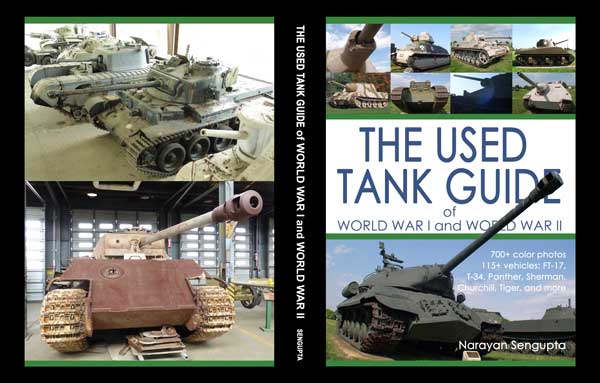

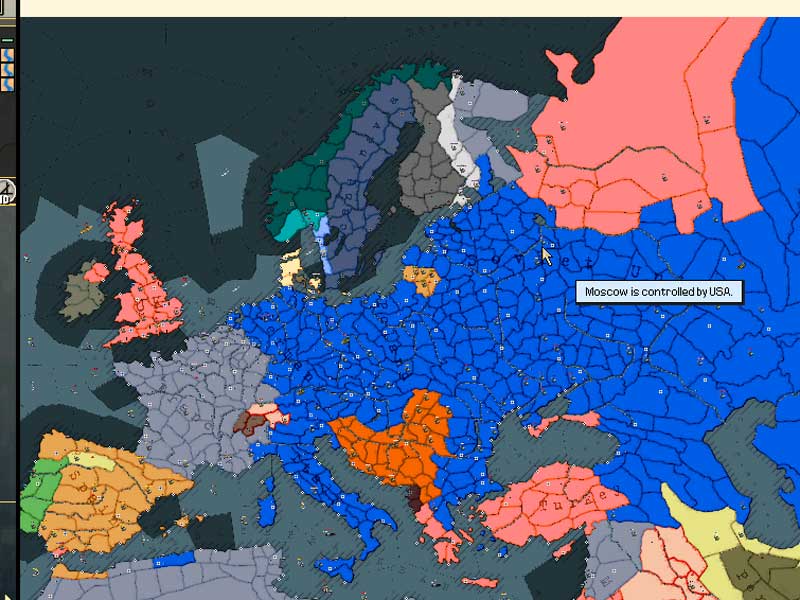



 French Military Victories...
French Military Victories...